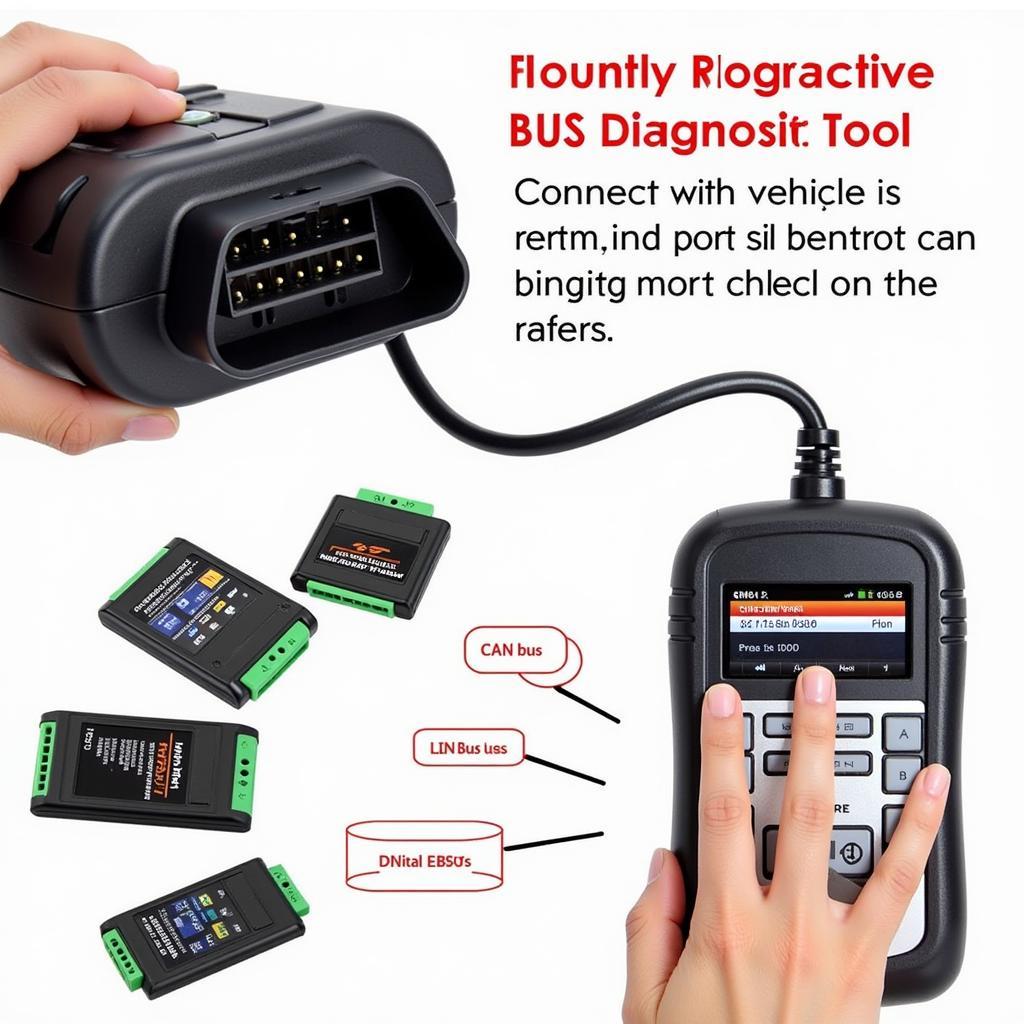The automotive industry is rapidly evolving, with vehicles becoming increasingly reliant on complex electronic systems. For automotive technicians, having the right tools to diagnose and repair these systems is crucial. A BUS diagnostic tool kit is essential for troubleshooting electronic control units (ECUs) that communicate via various data buses, such as CAN bus, LIN bus, and J1850. These tool kits can help you identify faults, read and clear diagnostic trouble codes (DTCs), and monitor live data streams from various vehicle systems.
One of the most valuable tools in your arsenal will be the Tech 2 Diagnostic Tool UK, offering a wide range of functionalities to help you pinpoint and address issues effectively.
Understanding the Importance of a BUS Diagnostic Tool Kit
Imagine this – a customer brings in their vehicle, complaining about intermittent engine misfires and warning lights illuminating on their dashboard. Without a reliable BUS diagnostic tool kit, you’re left relying on guesswork and intuition.
A BUS diagnostic tool kit empowers you to:
- Access and Read DTCs: Quickly identify the source of a problem by retrieving diagnostic trouble codes stored in the vehicle’s ECUs.
- Monitor Live Data Streams: Observe real-time sensor readings and component performance to diagnose intermittent issues and verify repairs.
- Perform Actuator Tests: Command individual components, such as solenoids or motors, to test their functionality and isolate faulty parts.
- Program and Configure ECUs: Update software, configure settings, and perform coding operations on ECUs to address specific vehicle issues or adapt to component replacements.
Key Features to Look for in a BUS Diagnostic Tool Kit
Navigating the market of BUS diagnostic tool kits can feel overwhelming. To simplify your decision, consider these key features:
1. Vehicle Coverage:
Ensure the tool kit supports a wide range of vehicle makes and models, including both domestic and foreign vehicles. Look for a kit that offers regular software updates to stay current with the latest vehicle models and protocols.
2. Protocol Compatibility:
Verify that the kit is compatible with various communication protocols commonly found in vehicles, such as CAN bus, LIN bus, J1850, and others. This ensures you can communicate with different ECUs within the vehicle.
 Compatible Protocols
Compatible Protocols
3. User Interface and Software:
Choose a tool kit with an intuitive user interface and easy-to-use software. A clear display, logical menu structure, and helpful prompts can significantly improve your diagnostic efficiency.
4. Functionality and Features:
Determine the specific functions and features that are essential for your needs. Some common features include:
- DTC reading and clearing
- Live data streaming
- Actuator tests
- ECU programming and coding
- Bi-directional control
- Special functions (e.g., DPF regeneration, key programming)
5. Durability and Build Quality:
Automotive repair environments can be demanding, so select a tool kit that is built to last. Look for a rugged design, quality connectors, and a protective case for storage and transport.
“Investing in a high-quality BUS diagnostic tool kit is non-negotiable for any serious automotive repair shop,” says John Miller, a veteran automotive electronics specialist with over 20 years of experience. “It’s the difference between efficiently diagnosing and repairing modern vehicles and losing valuable time and customers.”
Benefits of Using a Comprehensive BUS Diagnostic Tool Kit
A comprehensive BUS diagnostic tool kit offers numerous benefits:
- Increased Efficiency: Quickly diagnose and resolve issues, reducing downtime and improving productivity.
- Enhanced Accuracy: Eliminate guesswork with precise data and insights into vehicle systems.
- Cost Savings: Avoid unnecessary part replacements by accurately identifying faulty components.
- Improved Customer Satisfaction: Deliver faster and more reliable repairs, leading to happier customers and a better reputation.
 Enhanced Efficiency
Enhanced Efficiency
Common Applications of a BUS Diagnostic Tool Kit
A BUS diagnostic tool kit is versatile and can be used for various tasks:
- Engine Diagnostics: Diagnose engine-related issues such as misfires, fuel system problems, and emission control faults.
- Transmission Diagnostics: Troubleshoot transmission problems, including shifting issues, torque converter malfunctions, and electronic solenoid failures.
- ABS and Traction Control Diagnostics: Diagnose and repair issues related to anti-lock braking systems, traction control systems, and stability control systems.
- Airbag System Diagnostics: Identify and address problems with airbag control modules, sensors, and deployment circuits.
- Body Control Module Diagnostics: Diagnose and resolve issues related to power windows, central locking, lighting systems, and other body electronics.
Choosing the Right Tool Kit for Your Needs
Consider the following factors when selecting a BUS diagnostic tool kit:
- Budget: Determine your budget and look for a tool kit that offers the best value for your money.
- Skill Level: Choose a tool kit that aligns with your technical expertise and experience level. Some kits are designed for beginners, while others are more advanced and require specialized knowledge.
- Specific Needs: Consider the types of vehicles you work on most frequently and select a tool kit that meets those requirements.
“Don’t underestimate the importance of ongoing training and support,” adds Miller. “The automotive landscape is constantly evolving, so staying up-to-date with the latest technologies and diagnostic techniques is crucial.”
Conclusion
In the rapidly evolving world of automotive electronics, a reliable and comprehensive BUS diagnostic tool kit is indispensable. By investing in the right tool kit and staying informed about the latest advancements, you can ensure your workshop remains competitive and equipped to handle the challenges of modern vehicle repair. For expert advice on choosing the perfect BUS diagnostic tool kit for your needs, contact ScanToolUS at +1 (641) 206-8880 or visit our office at 1615 S Laramie Ave, Cicero, IL 60804, USA.
FAQs
1. What is the difference between a code reader and a BUS diagnostic tool kit?
A code reader can only read and clear basic diagnostic trouble codes (DTCs). In contrast, a BUS diagnostic tool kit offers more advanced features such as live data streaming, actuator tests, and ECU programming.
2. Can I use a BUS diagnostic tool kit on my own vehicle?
Yes, many BUS diagnostic tool kits are available for DIY enthusiasts and vehicle owners. However, it’s essential to choose a tool kit that aligns with your skill level and understanding of vehicle systems.
3. How often do BUS diagnostic tool kits require software updates?
Software updates are typically released periodically to ensure compatibility with the latest vehicle models and protocols. The frequency of updates varies depending on the tool kit manufacturer.
4. What are some common issues that a BUS diagnostic tool kit can help diagnose?
A BUS diagnostic tool kit can help diagnose a wide range of issues, including engine misfires, transmission problems, ABS faults, airbag system malfunctions, and body electronics problems.
5. Are there any online resources or training materials available for using a BUS diagnostic tool kit?
Yes, many online resources, training courses, and forums are dedicated to automotive diagnostics and the use of BUS diagnostic tool kits. These resources can provide valuable information, tips, and guidance for using your tool kit effectively.

